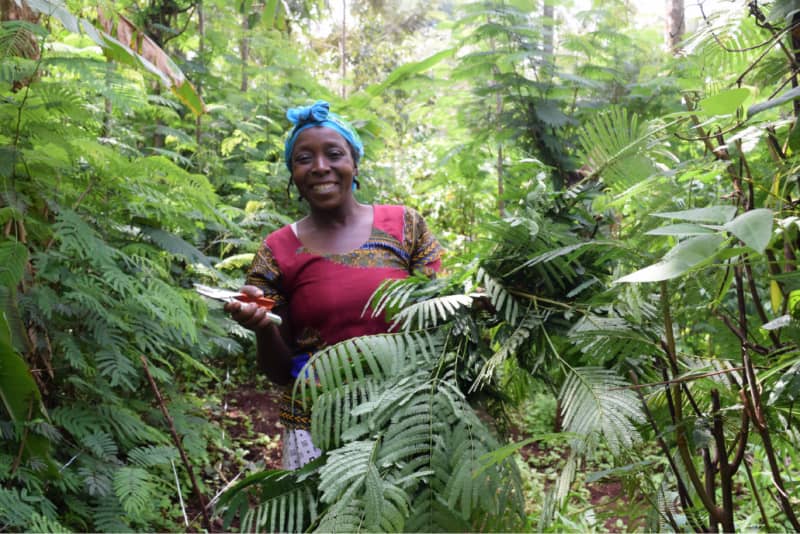Forest Garden farmers in East Africa are anxiously awaiting the growing desert locust swarms plaguing the Horn of Africa for the last two months. The locust threat has been mounting since January with the most concerning numbers in Kenya, Somalia, and Ethiopia. Swarms have also arrived in Uganda and Tanzania. Farmers who have yet to meet a swarm on their fields are not in the clear, as one fateful shift in wind direction can mean the end of acres upon acres of unharvested crops.
“Locusts are truly awful, they’re like big, heavy grasshoppers and if you get in their path they actually hurt when they fly into you,” says agroforestry expert and Executive Director of Trees for the Future John Leary. “Farmers facing potential locust swarms have reason to worry, they come in massive numbers and eat everything in sight.”
Desert locusts are considered the most dangerous migratory pest in the world. Swarms can span hundreds of kilometers, with as many as 40 million individual locusts per square kilometer. A desert locust eats its own weight in food every day, meaning even a small section of a swarm can wipe out enough food to feed 2,500 people – in one day. (Visit FAO.org for more locust statistics.)

Trees for the Future trains smallholder farmers in Sub-Saharan Africa to use agroforestry and regenerative agriculture techniques to increase their yields and revenues while eliminating deforestation. Their Forest Garden Approach has helped more than 73,000 smallholder farmers lift themselves out of hunger and poverty. Typically, Forest Garden farmers are less vulnerable to environmental impacts like unpredictable weather patterns and damaging pests. Through crop diversification and sustainable practices, Forest Garden farmers tend to fare better than their monocrop neighbors. But when it comes to staring down a swarm of locusts, Forest Garden farmers have little immunity.
If the locusts make their way to the Forest Gardens of Homa Bay and Ikinu, Trees for the Future Kenya Director Michael Muthui says they will threaten the food security and economic stability that hundreds of farmers have worked to achieve over the past two – four years.
“Forest Gardens have been an eye opener for farming families in Ikinu and Homa Bay, they have changed lives,” he said. “We have to protect ourselves from this invasion to safeguard the livelihoods of people.”
Forest Garden Farmers Watch for Locusts
As of February 13th, 2020, no Forest Garden farmer had reported a locust swarm to TREES staff. But farmers and staff alike are anticipating the threat and hoping that the thousands of Forest Gardens in East Africa don’t fall into the path of billions of hungry insects.

“Depending on when and where the locusts attack, it can be catastrophic,” says TREES Director of Programs Brandy Lellou. “Regenerative agroforestry sets farmers up for success on all fronts, but there is not much that can be done to stop locusts when they’re swarming.”
Forest Garden Technician Stephen Muhindi points out that the multi-purpose fodder trees on farmers’ property may be particularly vulnerable. “We are apprehensive about our Forest Gardens because insects prefer fodder trees which are common in our Forest Gardens. These swarms could take us steps back, bearing in mind that regeneration takes time.”
If the locusts strike Forest Gardens before the swarms dissipate, Trees for the Future farmers are at risk of losing much of what they’ve worked so hard to grow. However, Forest Garden farmers can take solace in some safeguards they’ve put in place.
Crop Diversity – Forest Garden farmers plant and harvest more than one crop, so their growing seasons are staggered throughout the year. They’ve already harvested some crops and have yet to plant others, so if locusts descend on their land and destroy everything, they have some foodstuffs to fall back on and will have other seeds to put in the ground.
Savings – Forest Garden farmers see a 400% average increase in income when practicing sustainable, regenerative agriculture. Many farmers in the program are saving for the first time in their lives.

Knowledge – TREES staff teach farmers everything there is to know about agroforestry. Locusts will eat the leafy growth of farmers’ trees, but sometimes trees are salvageable after the locusts move on. Armed with their agroforestry knowledge, Forest Garden farmers can prune their trees, removing damaged or dead growth and give the plants a chance to regenerate.
Support – If Forest Garden farmers are hit by the swarms, Lellou says TREES will coordinate a response to help farmers and their families recover as quickly as possible.
“We’ll have to assess damage and potentially appeal to donors for support,” Lellou says. “These farmers have worked so hard to revitalize their lands and build something special, we won’t let that work be for nothing.”
What’s the Solution?
This particular blight has been tied to climate change by many experts in the field. Warmer temperatures and wet conditions brought on by a changing climate has made for prime breeding conditions for the locusts. While the FAO and affected countries are responding to the swarms by spraying biopesticides, Leary says the long term solution is restoring the environment.
“Farming is tied to climate change in every way. Agriculture contributes to global warming and deforestation more than any other industry and farmers feel the pains of climate change on a regular basis. We are seeing this across Africa in the form of famine and locust plagues,” Leary says. “Farmers bear the burden of climate change, but they also have the power to turn it around.”
Trees for the Future Forest Garden farmers plant thousands of trees per hectare, sequestering 62.8 tons of carbon every 20 years.
“If we as a global society can change the way we grow our food, we will have a noticeable impact on climate change,” Leary says. “These apocalyptic scenes of locust swarms as well as floods, droughts, and famine are only going to increase if we don’t change right now.”

